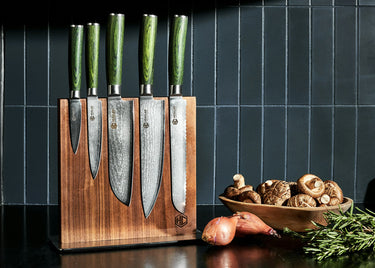Why Good Knives Matter

If you’ve ever been at your parents’ place for the holidays and opened the drawer to find a veritable Edward Scissorhands cutlery situation, you’re not alone. HexClad cooks know a good knife matters, but communicating that to some Boomer parents might result in a wave of the hand wave and a, “Well, it’s gotten me this far!”
Sigh. Not only do we get it, but we’re here with your six-point argument for investing in better knives. If you can swing it, gift our 7-piece Damascus Steel Knife Kit and set up a demo with a piece of paper, lemon and tomatoes.
“When you see the side-by-side comparison, that’s when you get the 'Aha!' moment,” says HexClad’s Food Director Laura Rege.
Rege knows from good knives, having started selling them in high school before honing her chops in culinary school and professional kitchens.
1. BETTER KNIFE = BETTER FOOD
Whether you’re in your Julia Child phase and want to make super-quick work of your onion mise en place or you want to showboat for your supper club, choosing a good knife is crucial. Sure, we could lead with the specifics of why a good knife is about the specific level of hardness or the delicate balance between a super-sharp blade and the tang—and we will get into those below—but there is one primary reason why buying a good knife matters: Your food will come out better. A good knife won’t bruise your pile of nicely picked herbs, nor will it hack away at your perfectly seared steak. A good knife will flow through food easily and precisely. Bottom line: Better knife skills start with a better knife.
2. COOKING IS EASIER
If our "tastier food" argument doesn’t convince you, this appeal to the lazier cooks among us might: Slicing or chopping with a dull knife is a more difficult task than using a good knife.
According to our Senior Product Marketing Manager and resident knife expert, Troy Schuler, a cook should have go-to tools that make work easier. Just as a carpenter would think of the saw, he said, a cook should think of their knife as an essential. “For people who think a knife is just a piece of metal, I say: Knives are the most important tool a chef uses to prepare food (beyond pans, of course).”
What’s more, just as a carpenter would choose a hammer for one job and a saw for another, different knives have different jobs: Pick a snub-nosed santoku knife if you prefer an up-and-down chopping motion and a chef’s knife if you find a rocking motion to be more natural. When you want to cut something solid like a watermelon or a pumpkin, the thinner, pointier tip of a chef’s knife is useful. Stick the point into the ingredient, and then use a firm rocking motion to wedge the blade into the food.
Deciding among knives? Schuler says that it’s about how you chop and what feels good to you. Santoku has more cutting surface and is great for a downward cut. A chef’s knife is better for rocking motion that keeps the tip on the board.

3. GREAT KNIVES ARE COMFY TO USE
If you’ve ever gotten a pinchy, nervy feeling from grabbing a knife handle before (raises hand), you’ll know knife comfort is a thing. You want to find a knife that fits your hand well. In HexClad’s knives, the tang (that’s the metal bit that extends into the handle) runs most of the way to its end. This contributes to a feeling of heft and balance. The pakkawood handle is ergonomic, too, making it easier to hold for a longer period of time.
4. SHARPNESS IS THE POINT
If your knife is sharp, then it can attack the skin of a hard winter squash like a kabocha as easily as slicing through butter. OK, we exaggerate. But the point stands that sharpness is critical in a knife. HexClad’s knives are made from Japanese Damascus steel. This ancient method of creating a blend of steels not only makes for a beautiful pattern on the blade, it includes 67 layers for a robust knife that will stay sharp day in and day out.
Both Rege and Schuler emphasized that keeping knives sharp is more about weekly maintenance with a honing steel than it is about using an at-home sharpening machine or attempting a whetstone. Instead, run your blades over the honing steel that comes in our 7-piece Damascus Steel Knife Kit once a week and send your knives to a service like Knife Aid once or twice a year depending on how frequently you cook.

5. IT’LL LAST FOR THE REST OF YOUR LIFE
As Rege said, “This is a place where spending a little now saves you money in the long run, since you won’t have to replace your knives as frequently, if at all.” (Side note: We offer a lifetime guarantee against defects.)
6. A GOOD KNIFE IS A SAFER KNIFE
If all else fails, said Schuler, remind mom that a safe knife is a sharp knife. Rege agreed, saying a dull knife is a dangerous one. Looking for proof? No need to google "kitchen accidents." Just hold up a piece of printer paper and slice from one end to the other with an old, dull knife and a HexClad one. The proof is in the paper.





